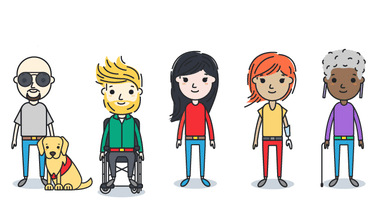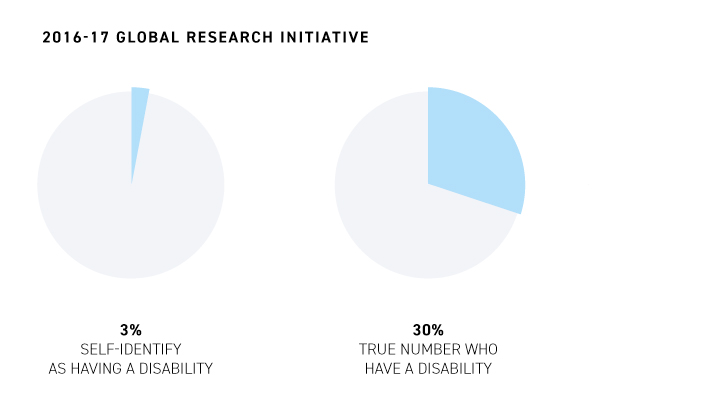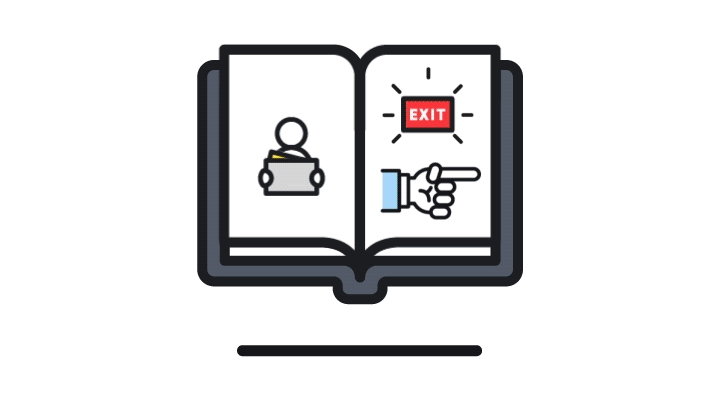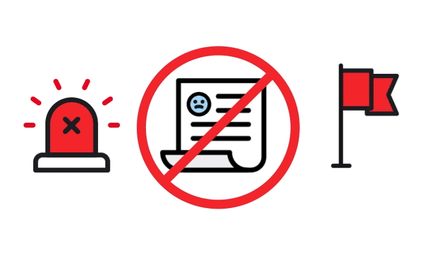As we’ve already covered, concentrating your efforts on hiring a truly diverse workforce is, not only the right thing to do, but it also drastically improves quality of life, opportunity, and business for all involved. Likewise, the strong promotion of diversity and inclusion in the workplace benefits everyone at every level of your business. Period. But in those published articles, we acknowledge that we missed discussing how important it is to include people with disabilities in your diversity, equity, & inclusion (DEI) focus. A sincere thank-you goes out to our readers who pointed this out!
So let’s talk about it, shall we?
The stats don’t lie
A 2016-17 global research initiative found an average of just over 3% of people in the U.S. self-identify as having a disability, while 30% is the true number of people who have a disability. As you might have guessed, invisible disabilities make up a large part of that 30%, but it’s also the fact that no one really discloses them unless there’s a need-to-know situation. That’s 30% of completely qualified, talented candidates you’re missing out on. It’s also important to remember that anyone can become a part of the disability community at any time for any number of reasons, so this number of candidates is always in flux.
Diverse minds = new ideas
The truth is, if you’re not factoring in disability inclusion into your hiring process, your company is lagging in innovation. For one, there is an untapped talent pool of more than 10.7 million people in the disability community looking for work. And this isn’t just an internal thing. Of the 75% of white-collar employees in the U.S. with disabilities who mentioned having ideas to benefit their company, 48% of those ideas would also be targeting customers within the disability community. Think of how many more customers will benefit from solutions imagined and created by people with a diversified outlook. By hiring people with disabilities, you’ll be increasing innovation tenfold for all people, while growing your bottom line, and that’s a fact.
Start at square one
Let’s take a look at your current workplace environment. Are you cultivating an inclusive culture that supports people with disabilities right now? That’s something you and your colleagues can prioritize even before beginning the hiring process. Examine your building’s infrastructure and physical environment (yep, even the employee handbook and benefits). Decide what your company can do to correct anything that prioritizes enabled people, understand how it negatively impacts people with disabilities, and start making changes toward achieving Universal Design (UD). Think: door accessibility, signage, captioning, and helpful lighting. It’s important to remember that these advances and changes in UD benefit all people, not just those with disabilities. An example: non-disabled people might casually use a wheelchair accessible button to open a door (especially during a global pandemic), even though this type of UD was not invented explicitly for them. Start questioning your company’s budgeting practices, too. Do you include specialized software, equipment, and diversity training in your budget? How do your healthcare benefits stack up? What about your company’s policies and attitudes around working from home—was it strictly ‘no way’ before the pandemic? Put people first and the solutions will follow.
Truth is, you won’t change your workplace overnight. But asking for input, listening, and learning how to make improvements for everyone will lead to tremendous advances in inclusion. Oh, and to dispel any misinformation, these beneficial changes vastly outweigh any preconceived costs. Your company will gain a better reputation in the eyes of customers, applicants and employees, yielding lower turnover rates and a serious boost in morale.
Next, adopt disability-friendly hiring principles
Start by examining your own careers website and applications for employment. Are these tools all accessible, easy to understand, and presented in clear text? Make sure of it! Otherwise you’re missing out on about a third of potential candidates due to easily fixable design. If the application process is unbearable or exclusionary, people will simply look elsewhere.
When it comes to your candidate search, go beyond LinkedIn, referrals, and your typical hiring practices. Reach out to organizations nearby that are run by and directly benefit the disability community in your area. Seek out professional organizations who might be able to help you find talent as well. For example, there might be an incredible writer nearby who contributes to The Guide Dog Foundation’s website. Or maybe you discover a freelance designer who’s got some of the most ADA-compliant websites and apps under their belt. You’ll never know until you research and reach out.
You’ve got your team—now make a plan
- Listen and act
Once you’ve hired more people with a wider range of talent and insight, start listening and acting on those previously missed opportunities. When a new employee expresses that they need some particular equipment or software to do their job, ensure they receive it and it’s working to their satisfaction. If someone suggests a unique idea that could drastically improve processes, environment, the company or the product, think together on how to make it happen and then create it. Be a proactive listener who focuses on long-term solutions. - Encourage and promote
Team members have just as much responsibility to encourage and promote diversity, equity and inclusion on a daily basis. Sure, you can bring in outside agencies to create custom diversity training solutions. Go for it! But for ongoing change, perhaps the easiest way is by fostering communication. Maybe you set up weekly chat roulettes where people opt-in to meet someone at random from a different team and just talk for an hour. Whatever method you choose, conversation is key to improving understanding, empathy, and inclusion.
And when it comes to on-the-job solutions, individual team members can research better ways to make their work more inclusive for all. Designers in particular will be in a great position to create more inclusive designs for a wider audience. Need help? There are plenty of independent contractors like Deque and accessiBe you can hire to ensure your websites become ADA-compliant. Another thing to keep in mind, though, is that not all “accessible designs” will work for everyone—which brings us back to the crucial point of first listening and learning from the employees with disabilities on your team. They’re the internal experts who can continually weigh in for future improvements.
- Repeat and reward
Both of the above steps will open your company up to exponential growth in inclusion, so repeat accordingly. But make sure you’re factoring in personal growth, too, with reward systems.
Offer avenues of empowerment for everyone, like mentor-mentee groups and leadership in volunteer work. Of course, this suggestion comes in addition to promoting people who clearly deserve it. Don’t forget that unconscious bias and unconscious demotion are very real discriminatory social issues everyone should know about. Remember to give credit, better titles, and pay where and when it’s due!
Want more tips on how to hire a diverse team? Check out our first article in this series. Do you also want tips on how to promote diversity and inclusion? Yea, we’ve also got an article for that. Or, just ready to hire talent? Artisan’s national can definitely help with that too.
This article was written by the Artisan team and edited by Megan Dausch and Dr. Shirley Vickery. Megan Dausch is a New York-based accessibility advocate and writer. Dr. Shirley Vickery is a school psychologist who specializes in supporting children with disabilities. A huge thank you to Megan & Shirley for their considered and informed perspectives!





